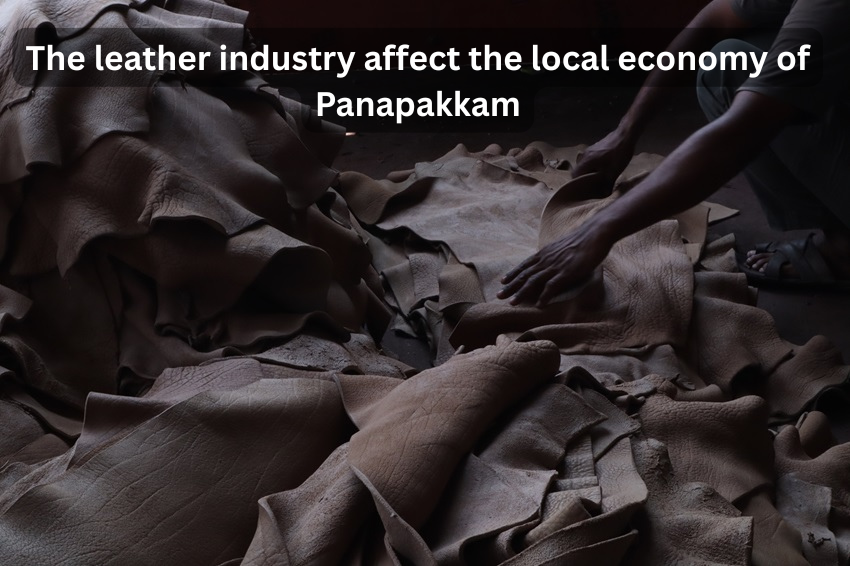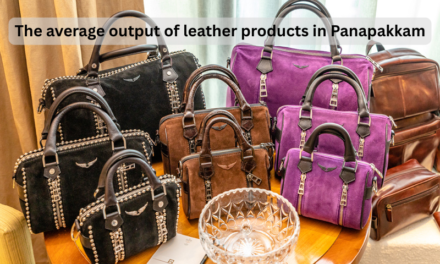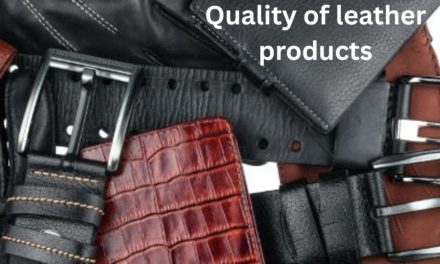The leather industry in Panapakkam has a profound and multi-faceted impact on the local economy, contributing to both economic growth and community development. As one of the most important sectors in Ranipet District and Tamil Nadu’s industrial ecosystem, the leather industry drives a wide range of economic activities, supports local businesses, and provides substantial employment. Here’s how the leather industry influences the local economy of Panapakkam:
1. Job Creation and Employment Opportunities
The leather industry is a major employer in Panapakkam, directly and indirectly creating thousands of jobs. The MLFAC Industrial Park, in particular, serves as a key source of employment, not only in manufacturing but also in supporting industries like logistics, packaging, and retail. The expansion of this sector has resulted in both skilled and unskilled job opportunities, which significantly benefit the local workforce.
- Direct employment: Thousands of workers are employed in leather manufacturing, tanning, footwear production, and leather goods manufacturing.
- Indirect employment: Additional jobs are created in services like logistics, maintenance, transportation, retail, and healthcare.
- Women’s employment: The industry has also contributed to the inclusion of women in the workforce, especially in roles such as footwear production, garment manufacturing, and quality control.
2. Income Generation and Local Spending
The employment generated by the leather industry directly boosts the income levels of workers and their families. Higher incomes contribute to the local economy in several ways:
- Increased consumer spending: Workers in the leather sector spend their wages on food, healthcare, education, and other daily needs, creating a positive economic cycle that benefits local businesses.
- Local businesses: The increased purchasing power supports local businesses such as grocery stores, restaurants, transportation services, and medical clinics, further fueling economic growth in Panapakkam.
3. Development of Infrastructure and Services
As the leather industry grows, there is often a corresponding increase in the demand for infrastructure development. The MLFAC Industrial Park has driven significant improvements in local infrastructure, including better roads, transportation networks, and utilities (water, power, etc.), which benefit both the industry and the community at large.
- Enhanced connectivity: Proximity to Chennai and the Chennai Port helps improve logistical networks, reducing transportation costs for both local businesses and manufacturers.
- Public services: With the increased economic activity, local government investment in healthcare, education, and public safety services has also risen, improving the overall quality of life for residents.
4. Exports and Foreign Exchange Earnings
Panapakkam’s leather industry is a key player in the export sector, with leather products being shipped to global markets such as the United States, Europe, and the Middle East. The export-driven nature of the industry not only brings foreign exchange earnings but also strengthens India’s position in the global leather market.
- Foreign investments: The leather industry attracts foreign investments, which can further enhance local economic activities, bring in new technologies, and improve the business environment in Panapakkam.
- Market expansion: As manufacturers in Panapakkam grow and expand, they tap into new markets, creating more trade opportunities and contributing to India’s overall export portfolio.
5. Entrepreneurial Growth
The leather industry has sparked the growth of small and medium-sized enterprises (SMEs) in Panapakkam, particularly in sectors related to accessories, leather processing, footwear components, and machinery supply. These businesses benefit from the local availability of raw materials, skilled labor, and proximity to large manufacturing hubs. Many entrepreneurs in Panapakkam have capitalized on the growth of the leather industry to establish new businesses, creating further economic diversification.
- Business incubators: The MLFAC Industrial Park serves as an incubator for startups and small enterprises, providing access to resources, technologies, and supply chains that help them scale.
- Leather exports: Local entrepreneurs are also finding opportunities to engage in direct exports of finished leather goods to international markets, tapping into the growing demand for high-quality leather products.
6. Technology Adoption and Innovation
As the leather industry in Panapakkam evolves, there is an increasing focus on innovation, especially in areas like sustainable leather production, eco-friendly tanning, and advanced manufacturing techniques. The adoption of cutting-edge technologies not only enhances the efficiency of local leather businesses but also makes Panapakkam a hub for technological development in leather processing.
- R&D investment: The industry’s focus on research and development (R&D), particularly around sustainable practices and green technologies, positions Panapakkam as a leader in environmentally conscious leather production.
- Skilled workforce: As businesses adopt new technologies, there is an increasing demand for workers with advanced technical skills, promoting skills development and attracting talent to the region.
7. Contribution to State and National Economies
Panapakkam’s leather industry contributes significantly to Tamil Nadu’s and India’s overall economy, particularly in the textile and leather sectors. The industry plays a vital role in generating tax revenues for both the state and central governments, which in turn are invested in further infrastructure development, education, and healthcare in the region.
- Government revenue: Taxes and duties from the leather exports, as well as corporate tax contributions from large manufacturing companies in the region, directly benefit the state and national economy.
- Regional growth: The growth of Panapakkam’s leather industry stimulates the entire Ranipet District, ensuring that the benefits of the sector extend beyond the immediate vicinity of Panapakkam itself.
8. Social and Community Development
The leather industry in Panapakkam has also supported local community development projects, particularly in the areas of education, healthcare, and women’s empowerment. Many companies are involved in corporate social responsibility (CSR) activities, contributing to the welfare of the local population by funding schools, healthcare centers, and skill development programs.
- Women’s empowerment: The industry provides many women with employment opportunities, particularly in footwear production, leather goods, and quality control, promoting gender equality in the workforce.
- Social programs: Companies also engage in CSR initiatives that support local education programs, healthcare services, and environmental conservation efforts, directly benefiting the Panapakkam community.
Conclusion
The leather industry in Panapakkam plays a vital role in shaping the local economy. It creates direct and indirect employment, supports infrastructure development, promotes exports, encourages entrepreneurship, and enhances the overall socio-economic status of the region. With the MLFAC Industrial Park continuing to expand and modernize, the leather sector will likely remain a central driver of economic prosperity in Panapakkam for years to come.
Hashtags
#PanapakkamEconomicImpact #LeatherIndustryGrowth #LocalEconomyBoost #PanapakkamLeatherSector #TamilNaduIndustrialDevelopment #LeatherManufacturingBenefits #EconomicGrowthTN #FootwearIndustryImpact #PanapakkamJobCreation #LeatherExportsEffect







